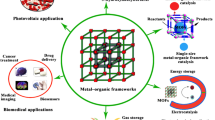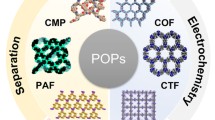Abstract
In this study, we prepared a series of amine-functionalized polysilsesquioxanes (PSQs) containing cross-linked structures via the hydrolytic condensation of mixtures of amino-group-containing organotrialkoxysilanes and bridged organoalkoxysilanes in water under CO2 gas bubbling, followed by lyophilization and heat treatment at 120 °C for 4 h. Among the resulting materials, the amine-functionalized PSQ (PSQ-Am-CL-0.67) prepared from a mixture of 3-aminopropyltrimethoxysilane and bis[3-(trimethoxysilyl)propyl]amine (molar ratio 1:1) as the starting materials in CO2-gas-bubbling water with a solution concentration of 0.67 mol/L exhibited relatively high CO2 adsorption capacity under dry conditions (2.30 mmol(CO2)/g(material)). Moreover, even after repeating the adsorption and desorption of CO2 10 times, the CO2 adsorption capacity of PSQ-Am-CL-0.67 did not noticeably reduce, indicating that it could be used repeatedly as a CO2 capture material.

Highlights
-
Amine-functionalized polysilsesquioxanes (PSQs) containing cross-linked structures were prepared.
-
The resulting PSQs exhibited a relatively high CO2 adsorption capacity under dry conditions.
-
The resulting PSQs can be used repeatedly as CO2 capture materials.









Similar content being viewed by others
References
Abu-Zahra MRM, Schneiders LHJ, Niederer JPM, Feron PHM, Versteeg GF (2007) CO2 capture from power plants Part I. A parametric study of the technical performance based on monoethanolamine. Int J Greenh Gas Con 1:37–46
Luis P (2016) Use of monoethanolamine (MEA) for CO2 capture in a global scenario: consequences and alternatives. Desalination 380:93–99
Hiyoshi N, Yogo K, Yashima T (2005) Adsorption of carbon dioxide on aminosilane-modified mesoporous silica. J Jpn Petrol Inst 48:29–36
Loganathan S, Ghoshal AK (2017) Amine tethered pore-expanded MCM-41: a promising adsorbent for CO2 capture. Chem Eng J 308:827–839
Sanz-Pérez ES, Dantas TCM, Arencibia A, Calleja G, Guedes APMA, Araujo AS, Sanz R (2017) Reuse and recycling of amine-functionalized silica materials for CO2 adsorption. Chem Eng J 308:1021–1033
Lashaki MJ, Sayari A (2018) CO2 capture using triamine-grafted SBA-15: The impact of the support pore structure. Chem Eng J 334:1260–1269
Laine RM, Zhang C, Sellinger A, Viculis L (1998) Polyfunctional cubic silsesquioxanes as building blocks for organic/inorganic hybrids. Appl Organomet Chem 12:715–723
Choi J, Harcup J, Yee AF, Zhu Q, Laine RM (2001) Organic/inorganic hybrid composites from cubic silsesquioxanes. J Am Chem Soc 123:11420–11430
Kim KM, Chujo Y (2003) Organic–inorganic hybrid gels having functionalized silsesquioxanes. J Mater Chem 13:1384–1391
Kaneko Y, Iyi N, Matsumoto T, Kitamura K (2005) Preparation of higher-ordered inorganic–organic nanocomposite composed of rodlike cationic polysiloxane and polyacrylate. J Mater Chem 15:1572–1575
Tanaka K, Adachi S, Chujo Y (2009) Structure-property relationship of octa-substituted POSS in thermal and mechanical reinforcements of conventional polymers. J Polym Sci Part A: Polym Chem 47:5690–5697
Yu X, Zhong S, Li X, Tu Y, Yang S, Van Horn RM, Ni C, Pochan DJ, Quirk RP, Wesdemiotis C, Zhang WB, Cheng SZD (2010) A giant surfactant of polystyrene-(carboxylic acid-functionalized polyhedral oligomeric silsesquioxane) amphiphile with highly stretched polystyrene tails in micellar assemblies. J Am Chem Soc 132:16741–16744
Wang F, Lu X, He C (2011) Some recent developments of polyhedral oligomeric silsesquioxane (POSS)-based polymeric materials. J Mater Chem 21:2775–2782
Kuo SW, Chang FC (2011) POSS related polymer nanocomposites. Prog Polym Sci 36:1649–1696
Tanaka K, Chujo Y (2012) Advanced functional materials based on polyhedral oligomeric silsesquioxane (POSS). J Mater Chem 22:1733–1746
Sun J, Chen Y, Zhao L, Chen Y, Qi D, Choi KM, Shin DS, Jiang J (2013) Porphyrin-POSS molecular hybrids. Chem Eur J 19:12613–12618
Alves F, Nischang I (2013) Tailor-made hybrid organic–inorganic porous materials based on polyhedral oligomeric silsesquioxanes (POSS) by the step-growth mechanism of thiol-ene “click” chemistry. Chem Eur J 19:17310–17313
Guo M, David É, Fréchette M, Demarquette NR (2017) Polyethylene/polyhedral oligomeric silsesquioxanes composites: dielectric, thermal and rheological properties. Polymer 115:60–69
Li Y, Dong XH, Zou Y, Wang Z, Yue K, Huang M, Liu H, Feng X, Lin Z, Zhang W, Zhang WB, Cheng SZD (2017) Polyhedral oligomeric silsesquioxane meets “click” chemistry: rational design and facile preparation of functional hybrid materials. Polymer 125:303–329
Zhang W, Camino G, Yang R (2017) Polymer/polyhedral oligomeric silsesquioxane (POSS) nanocomposites: an overview of fire retardance. Prog Polym Sci 67:77–125
Baney RH, Itoh M, Sakakibara A, Suzuki T (1995) Silsesquioxanes. Chem Rev 95:1409–1430
Loy DA, Baugher BM, Baugher CR, Schneider DA, Rahimian K (2000) Substituent effects on the sol–gel chemistry of organotrialkoxysilanes. Chem Mater 12:3624–3632
Cordes DB, Lickiss PD, Rataboul F (2010) Recent developments in the chemistry of cubic polyhedral oligosilsesquioxanes. Chem Rev 110:2081–2173
Kaneko Y, Iyi N, Kurashima K, Matsumoto T, Fujita T, Kitamura K (2004) Hexagonal-structured polysiloxane material prepared by sol–gel reaction of aminoalkyltrialkoxysilane without using surfactants. Chem Mater 16:3417–3423
Kaneko Y, Iyi N, Matsumoto T, Kitamura K (2005) Synthesis of rodlike polysiloxane with hexagonal phase by sol–gel reaction of organotrialkoxysilane monomer containing two amino groups. Polymer 46:1828–1833
Kaneko Y, Iyi N (2007) Sol–gel synthesis of rodlike polysilsesquioxanes forming regular higher-ordered nanostructure. Z Kristallogr 222:656–662
Kaneko Y, Toyodome H, Shoiriki M, Iyi N (2012) Preparation of ionic silsesquioxanes with regular structures and their hybridization. Int J Polym Sci 2012: 684278
Toyodome H, Kaneko Y, Shikinaka K, Iyi N (2012) Preparation of carboxylate group-containing rod-like polysilsesquioxane with hexagonally stacked structure by sol–gel reaction of 2-cyanoethyltriethoxysilane. Polymer 53:6021–6026
Kaneko Y, Toyodome H, Mizumo T, Shikinaka K, Iyi N (2014) Preparation of a sulfo-group-containing rod-like polysilsesquioxane with a hexagonally stacked structure and its proton conductivity. Chem Eur J 20:9394–9399
Harada A, Shikinaka K, Ohshita J, Kaneko Y (2017) Preparation of a one-dimensional soluble polysilsesquioxane containing phosphonic acid side-chain groups and its thermal and proton-conduction properties. Polymer 121:228–233
Kaneko Y (2018) Ionic silsesquioxanes: Preparation, structure control, characterization, and applications. Polymer 144:205–224
Kaneko Y, Shoiriki M, Mizumo T (2012) Preparation of cage-like octa(3-aminopropyl)silsesquioxane trifluoromethanesulfonate in higher yield with a shorter reaction time. J Mater Chem 22:14475–14478
Tokunaga T, Shoiriki M, Mizumo T, Kaneko Y (2014) Preparation of low-crystalline POSS containing two types of alkylammonium groups and its optically transparent film. J Mater Chem C 2:2496–2501
Ishii T, Mizumo T, Kaneko Y (2014) Facile preparation of ionic liquid containing silsesquioxane framework. Bull Chem Soc Jpn 87:155–159
Tokunaga T, Koge S, Mizumo T, Ohshita J, Kaneko Y (2015) Facile preparation of a soluble polymer containing polyhedral oligomeric silsesquioxane units in its main chain. Polym Chem 6:3039–3045
Ishii T, Enoki T, Mizumo T, Ohshita J, Kaneko Y (2015) Preparation of imidazolium-type ionic liquids containing silsesquioxane frameworks and their thermal and ion-conductive properties. RSC Adv 5:15226–15232
Harada A, Koge S, Ohshita J, Kaneko Y (2016) Preparation of a thermally stable room temperature ionic liquid containing cage-like oligosilsesquioxane with two types of side-chain groups. Bull Chem Soc Jpn 89:1129–1135
Imai K, Kaneko Y (2017) Preparation of ammonium-functionalized polyhedral oligomeric silsesquioxanes with high proportions of cagelike decamer and their facile separation. Inorg Chem 56:4133–4140
Matsumoto T, Kaneko Y (2018) Selective and high-yielding preparation of ammonium-functionalized cage-like octasilsesquioxanes using superacid catalyst in dimethyl sulfoxide. Chem lett 47:864–867
Yanagie M, Kaneko Y (2018) Preparation of irrefrangible polyacrylamide hybrid hydrogels using water-dispersible cyclotetrasiloxane or polyhedral oligomeric silsesquioxane containing polymerizable groups as cross-linkers. Polym Chem 9:2302–2312
Liu J, Kaneko Y (2018) Preparation of polyhedral oligomeric silsesquioxanes containing carboxyl side-chain groups and isolation of a cage-like octamer using clay mineral. Bull Chem Soc Jpn 91:1120–1127
Maeda D, Ishii T, Kaneko Y (2018) Effect of lengths of substituents in imidazolium groups on the preparation of imidazolium-salt-type ionic liquids containing polyhedral oligomeric silsesquioxane structures. Bull Chem Soc Jpn 91:1112–1119
Matsumoto T, Kaneko Y (2019) Effect of reaction temperature and time on the preferential preparation of cage octamer and decamer of ammonium-functionalized POSSs. Bull Chem Soc Jpn 92:1060–1067
Maeda D, Matsukawa K, Kusaka Y, Kaneko Y (2019) Preparation of a soluble polysilsesquioxane containing macrocyclic structure and capture of palladium ion. Polym J 51:439–447
Kong Y, Shen X, Cui S, Fan M (2015) Facile synthesis of amine hybrid aerogel with high adsorption efficiency and regenerability for air capture via solvothermal-assisted sol–gel process and supercritical drying. Green Chem 17:3436–3445
Kong Y, Shen X, Fan M, Yang M, Cui S (2016) Dynamic capture of low-concentration CO2 on amine hybrid silsesquioxane aerogel. Chem Eng J 283:1059–1068
Ojo KO, Golovko LV, Gomza YP, Vasiliev AN (2012) Mesoporous silsesquioxanes with high contents of surface amine groups. Silicon 4:189–195
Acknowledgements
This work was partly carried out at the Joint Research Center for Environmentally Conscious Technologies in Materials Science (project No. 30003) at ZAIKEN, Waseda University.
Author information
Authors and Affiliations
Corresponding author
Ethics declarations
Conflict of interest
The authors declare that they have no conflict of interest.
Additional information
Publisher’s note: Springer Nature remains neutral with regard to jurisdictional claims in published maps and institutional affiliations.
Supplementary information
Rights and permissions
About this article
Cite this article
Sainohira, Y., Fujino, K., Shimojima, A. et al. Preparation of CO2-adsorbable amine-functionalized polysilsesquioxanes containing cross-linked structures without using surfactants and strong acid or base catalysts. J Sol-Gel Sci Technol 91, 505–513 (2019). https://doi.org/10.1007/s10971-019-05072-6
Received:
Accepted:
Published:
Issue Date:
DOI: https://doi.org/10.1007/s10971-019-05072-6




